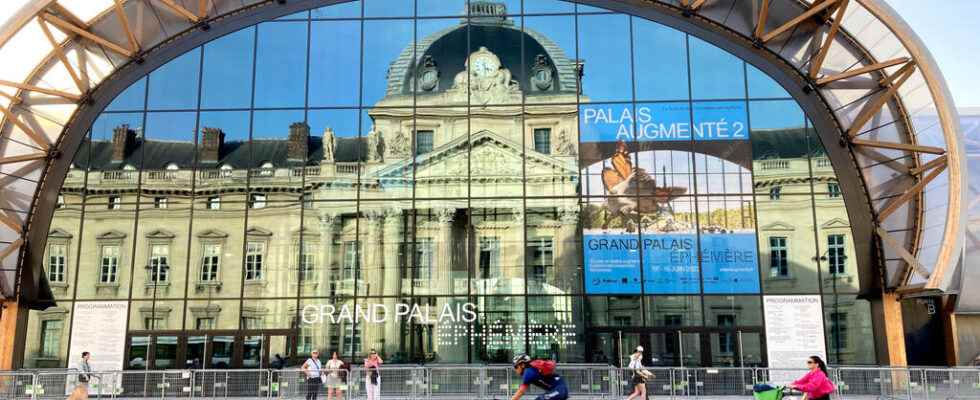It is a pioneering festival, entirely devoted to artistic creation in augmented reality. From June 17 to 19, the “Augmented Palace #2” brings together at the Grand Palais Éphémère in Paris a dozen original immersive works in large format to astonish and dazzle the general public. State of digital art with director Roei Amit.
RFI: You are the digital director of the immersive Grand Palais at the Réunion des musées nationaux (RMN)-Grand Palais and you designed the concept of the Festival Augmented Palace. What did you learn from the first edition in 2021 ?
Roei Amit : Edition #1 was a kind of “prove of concept”, we tested the concept during the Covid pandemic. It was very rich in lessons regarding the work of artists, for example how do you create large-scale works for a large space? And also in relation to the way in which the public perceived and practiced the presence of these unpublished works. This success, with more than 10,000 visitors during a weekend, made us want to do it again this year and add some “lab” type experiences.
► Read also : Le Grand Augmented 2021 launches artistic creation in augmented reality
Have you succeeded in creating a new audience for the Grand Palais and contemporary art ?
We had a very large, very varied audience. And we found that there is no technological barrier. People were of all ages and they came in a very simple and obvious way to appropriate the use of this art through their smartphone. Certainly, the use of the smartphone is very widespread today, and here they discovered that the artistic use of the smartphone is also very easy.
the Augmented Palace also draws up an inventory of knowledge and technological innovations related to digital art. Could you give us an emblematic example ?
Take the work Soundscape artists Mouawad and Laurier. They both created a world of very poetic structures, but not just visual ones. It is a world that reacts in real time to the different sounds emitted in the space surrounding the work. So, if the spectator emits his own sound, this sound acts directly on the work. The work is unique for each viewer. It is the technological evolution that allows this type of artistic expression and that creates these works that are infinitely unique.
In Ogun and Mars, for a cosmogony of the invisible, the Martinican-born artist Julien Creuzet, born in 1986 in Blanc-Mesnil, plays in a very original way with English, Portuguese-speaking, Spanish-speaking, French-speaking, but also Pan-African references. What is the link of this work with the African universe ?
There are two very important elements in this work. First, it is a kind of library. A giant removes 80 literary works on the subject from his own head. Secondly, the dance practiced by the two giants of the work comes from African dances. One of the giants dances the bèlè, this dance of resistance invented by slaves in Martinique. By merging these elements in this augmented reality work, the artist shows the artistic maturity of the approach. Because, beyond the experimental aspect and the research on the forms, the work is also committed to the content, to ideas, concepts.
The works presented at the Augmented Palace also question the place of the spectator. How digital art changes the relationship between artwork and viewer ?
Through the works presented here, we realize in a very concrete way that art always takes place in the eyes of the beholder. Each spectator looks at his screen, his smartphone, the space of the Grand Palais Éphémère is practically empty. With the naked eye, you can’t see anything. And when you look at what you have in your hand, the smartphone screen, you are in the presence of the works. This creates a new type of relationship between the spectators. One could say that in digital art, the pixels are the pigments and the screen becomes a canvas, but an interactive canvas where the artist and the visitor meet.
In the work I-Dance, the place of the spectator also changes when his avatar becomes a dancer performing choreographies by well-known choreographers such as Boris Charmatz or Abou Lagraa. But what does it change for the creator ?
In I-Dance, the public “becomes avatarized”, the spectator transforms into a very realistic avatar. The spectator is thus inserted into the choreography of very renowned choreographers. It’s a new way of appropriating dance. It is yet another way of exchanging traditional places and roles and how one usually acts in the space of an exhibition.
Beyond the exhibited works, the Augmented Palace also offers conferences with artists, philosophers, contemporary art and digital culture professionals. Among other things, you address the theme “ Art and Resistance “. What resistance are we talking about when we talk about digital art ?
We’re talking about all the resistance to worlds one could imagine. For example, the work of Julien Creuzet speaks of a real resistance to received ideas. And there is also the search for new forms and a new society by artists. They try to be at the forefront of shapes and ideas. But it’s up to everyone to find their own resistance.
